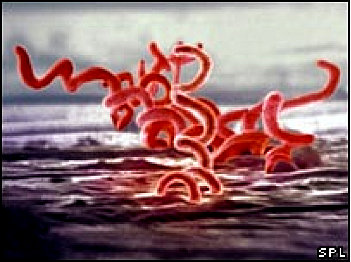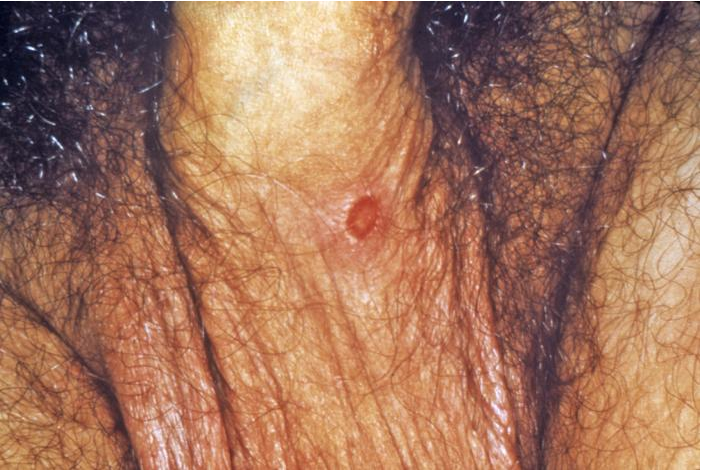Let’s Talk!
Syphilis does not make headlines like the AIDS virus probably due to the fact that since the 1980s, worldwide viral infections have greatly increased compared to bacterial infections. Although less widespread, it is important that you be informed about this serious infection and that you know how to better protect yourself.
According to a 2009 Public Health Agency of Canada report, the Canadian rate of annual reported cases of syphilis is 5 per 1000 people. Ontario and Quebec have the highest number of reported syphilis cases with 375 and 176 cases respectively.
Canadian clinics are obligated to report syphilis cases to government agencies. It is a very important measure because any person who had sexual contact with a syphilis-infected person needs to be notified and tested in order to prevent long-term permanent health problems.
Syphilis is caused by the spirochete bacterium Treponema pallidum subspecies pallidum. There is evidence that syphilis was brought from the Americas to Europe by Christopher Columbusâ infected crewmen in 1494.
 Syphilis Bacteria (Right) Syphilis can infiltrate intact mucous membranes and compromised skin. Therefore syphilis can be transmitted through kissing, oral/vaginal/anal sex. 30 to 60% of people exposed to primary or secondary syphilis will contract the disease. It can also be passed on from a mother to her fetus during pregnancy or at birth, resulting in congenital syphilis.
Syphilis Bacteria (Right) Syphilis can infiltrate intact mucous membranes and compromised skin. Therefore syphilis can be transmitted through kissing, oral/vaginal/anal sex. 30 to 60% of people exposed to primary or secondary syphilis will contract the disease. It can also be passed on from a mother to her fetus during pregnancy or at birth, resulting in congenital syphilis.
It is difficult to culture the syphilis bacterium because it is unable to survive without a host (i.e., a human body) for more than a few days. This bacterium has a small genome and therefore it is unable to make most of its macronutrient in order to stay alive. Syphilis cannot grow on artificial media (i.e., petri dish) and has a slow doubling time of more than 30 hours.
Indian MD Vibhu Mendiratta reported that new prevalent sexual practices (i.e., anal sex) could have contributed to the global increase of syphilis cases. Also, syphilis may be the most common STI responsible for the spread of HIV. Dual diagnosis of syphilis and HIV is more common among men who have sex with men, intravenous drug abusers, and prostitutes.
There are four stages of syphilis infection: primary, secondary, latent, and tertiary. The primary stage often presents itself as a firm, painless, non-itchy single chancre in the genitalia area. The second stage tends to provoke a diffuse rash that affects the palms of hands and soles of feet. Latent syphilis is usually asymptomatic whereas tertiary syphilis has the classic symptoms of gummas (small soft swellings), neurological/cardiac damage. Syphilis is called the âgreat imitatorâ because of the various symptoms that an infected person may present.
 Primary Syphilis Chancre on Penis (Left)Â Venereal Disease Research Laboratory (VDRL) is a nontreponemal syphilis test, which means that it indirectly detects markers of infection. Indeed when the body is infected, it produces antibodies to fight foreign organisms. These antibodies are detected by adding an antigen (a colorless alcoholic solution ) to the blood serum.
Primary Syphilis Chancre on Penis (Left)Â Venereal Disease Research Laboratory (VDRL) is a nontreponemal syphilis test, which means that it indirectly detects markers of infection. Indeed when the body is infected, it produces antibodies to fight foreign organisms. These antibodies are detected by adding an antigen (a colorless alcoholic solution ) to the blood serum.
VDRL is used for initial screening of syphilis and widely used globally because it is simple, sensitive (correctly identifies infected individuals at a rate of 70-90%) and inexpensive. In fact, many patients perform this test on their own.
The two shortcomings of the VDRL test are the prozone phenomenon (false-negative due too high antibodies versus antigen markers) and biological false positive (due to other diseases that the person might already have). Case in point, an HIV positive individual who has not been properly treated for their HIV may have an inaccurate test result from a syphilis blood test, showing a false-negative due to the prozone phenomenon. However, nontreponemal tests are reliable enough to help monitor the progression of syphilis during and after treatment.
Syphilis is called the âGreat Imitatorâ because it can present various symptoms that can be mistaken for other diseases. A false-positive syphilis diagnosis could be due to other chronic health issues such as systemic lupus, drug addiction, liver disease, and rheumatoid arthritis. Short-term conditions such as malaria, tuberculosis, and pregnancy and immunization can also give a false positive.
Pregnant women should be tested for syphilis during their first prenatal visit, during their third trimester, and right after giving birth. It is recommended to use a nontreponemal test (i.e., VDRL ) and if it is positive, to confirm the diagnosis with a treponemal (i.e., fluorescent treponemal antibody absorption or FTA-ABS) test.
Treatment for syphilis was discovered in 1943, therefore the rate of infection has dramatically dropped since that time. Infection rates have remained relatively stable throughout the world since then.
 Penicillin GÂ (Left)Â Syphilis can be cured with intramuscular antibiotics penicillin G or ceftriaxone. If the patient is allergic to penicillin, the doctor can prescribe oral doxycline or azithromycin.
Penicillin GÂ (Left)Â Syphilis can be cured with intramuscular antibiotics penicillin G or ceftriaxone. If the patient is allergic to penicillin, the doctor can prescribe oral doxycline or azithromycin.
The syphilis treatment is considered to be successful if the initial concentration of antibodies decreases fourfold by: 1) 6-12 months for the primary, secondary or latent syphilis; 2) 12-24 months for late latent syphilis or syphilis of unknown duration.
To prevent syphilis, it is recommended to use a latex condom; get tested at least once a year for syphilis; be in a sexually monogamous relationship, and refrain from heavy use of alcohol and drugs that may increase risky sexual behaviour. However, the use of condoms only reduces the risk of infection because infected individuals can have contagious lesions in various parts of their bodies.
Syphilis is not as prevalent as other viral infections such as the Human Papilloma Virus and HIV, and this fact can lead to a lack of knowledge about this serious disease. It is important to underline the fact that syphilis makes people more vulnerable to other sexually transmitted infections such as HIV because of the sores that appear on the infected personâs skin.
This sexually transmitted infection is very contagious, and many may unknowingly be infected. If treated early and effectively, there are few long-term negative health effects. Regular checks, the use of latex condoms, and a limited number of sexual partners are all ways to prevent the spread of this sexual infection called âthe Great Imitatorâ.
Literary Truths
Here are more details about the typical 4 stages of syphilis infection:
- Primary syphilis: a skin lesion (chancre) appears about 21 days after the initial exposure. The chancre is a 0.3 to 3.0 cm firm, painless and non-itchy skin ulceration (although this lesion can take various forms). The lesion is usually found on the genitals: on the cervix for women (44%); on the penis for heterosexual men (99%); and on the anus or rectum for men who have sex with men. Lymph nodes often enlarge around the area of the chancre about 1 week later. The lesion may last 3 to 6 weeks if not treated and is contagious.
- Secondary syphilis: starts 4 to 10 weeks after the initial infection. Asymmetrical reddish-pink, a non-itchy rash may appear on the trunk, extremities, palms, and soles. The rash usually becomes a multitude of flat, red areas on the skin that are covered with small bumps (or maculopapular). Mucous membranes may be covered with whitish wart-like lesions (or condyloma latum). These lesions are contagious. Other symptoms may include fever, sore throat, malaise, weight loss, hair loss, and headache. The symptoms disappear after 3 to 6 weeks and many infected individuals report not having had the classic primary syphilis chancre.
- Latent syphilis: there are no symptoms of the disease, but there is serological proof (syphilis antibodies in the blood serum). Early latent syphilis is less than 1 year after the second phase, whereas the late latent is more than 1 year after the second phase.
- Tertiary syphilis: If left untreated, 1/3 of infected people will develop the tertiary form 3 to 15 years after the initial infection. There are 3 forms: a) gummatous syphilis (15%), b) late neurosyphilis (6.5%), and c) cardiovascular syphilis (10%).  Infected individuals at that stage are not infectious.
a) Gummatous syphilis: occurs on average 15 years after the initial infection. Gummas (or small to large, soft swellings) often appear on the skin, bone, and liver.
b) Late neurosyphilis: develops 4 to 25 years after the initial infection. The nervous system is infected with syphilis. Symptoms include general muscular weakness (or paresis), poor balance, and lightning pains in the lower extremities. Late meningovascular syphilis often presents with apathy, seizures, dementia, loss of coordination (tabes dorsalis), and constriction of both pupils when the person focuses on near objects but not on a bright light (or Argyll Robertson pupils).
c) Cardiovascular syphilis: occurs 10 to 30 years after the initial infection. The infected person may develop an inflammation of the aorta which may result in an excessive localized enlargement of the artery (or aneurysm).
Truth in Motion
References
Acharjya, Basanti, and Surajit Nayak. “VDRL test and its interpretation.” Indian Journal of Dermatology 57.1 (2012): 3.
Attaullah, Sobia, Jabbar Khan, and Sanaullah Khan. “Trend of transfusion-transmitted infections frequency in blood donors: provide a road map for its prevention and control.” Journal of Translational Medicine 10 (2012): 20.
Chander, Ram, Arpita Jain, and Vibhu Mendiratta. “Current status of acquired syphilis: a hospital-based 5-year study.” Indian Journal of Sexually Transmitted Diseases and AIDS 33.1 (2012): 32.
Dhaliwal, Shagun, Alan Menter, and Mahir Patel. “Secondary syphilis and HIV.” Baylor University Medical Center Proceedings 25.1 (2012): 87.
Public Health Agency of Canada – Syphilis

I’m really glad I have found this info. Today bloggers only publish about gossips and it’s annoying. A good web site with exciting content, that’s what I need.
I have been checking out some of your articles, and I must say pretty good stuff. I will definitely bookmark your website.
I really appreciate this post. I have been looking all over for this! Thank goodness I found it on Bing. You’ve made my day! Thanks again.
Loving the information on this internet site, you have done great job on the posts.
I love the effort you have put into this. Thanks for all the great articles.
Most of what I read online is trash and copy paste but I think you offer something different. Keep it like this.
As soon as I visited this site I went on reddit to share some of the love with them.